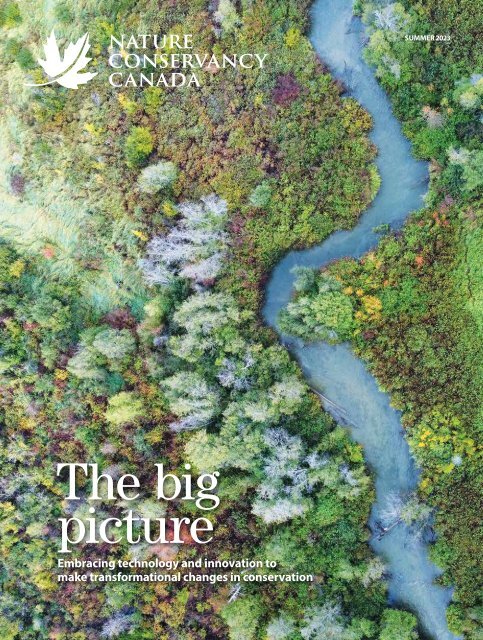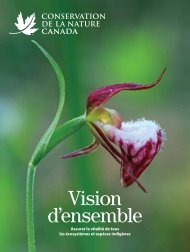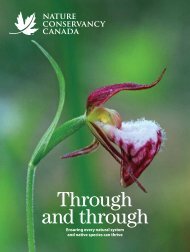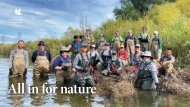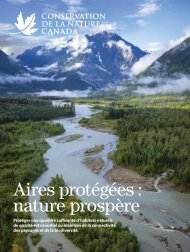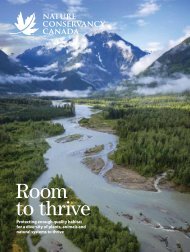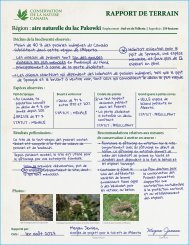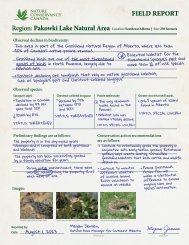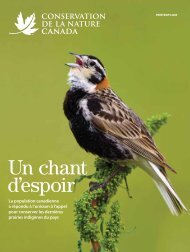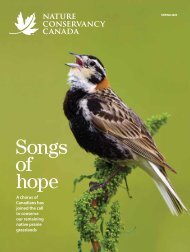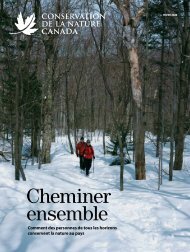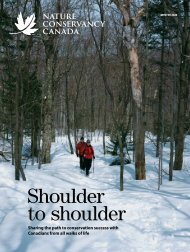NCC Magazine, Summer 2023
You also want an ePaper? Increase the reach of your titles
YUMPU automatically turns print PDFs into web optimized ePapers that Google loves.
SUMMER <strong>2023</strong><br />
The big<br />
picture<br />
TKTKTKTKTKTKT<br />
Embracing technology and innovation to<br />
make transformational changes in conservation<br />
natureconservancy.ca<br />
WINTER 2021 1
SUMMER <strong>2023</strong><br />
CONTENTS<br />
Nature Conservancy of Canada<br />
4 Fragile beauty<br />
At-risk plant species of Canada’s<br />
Prairie grasslands.<br />
6 Nebo<br />
Spectacular landscapes abound<br />
where the boreal forest meets the<br />
Prairie grasslands in Saskatchewan.<br />
7 Big Backyard<br />
BioBlitz<br />
Connect with nature, and with<br />
each other.<br />
7 Nature’s lure<br />
Fishing, and the call of the water,<br />
is a constant draw for Kimberly Orren,<br />
executive director of Fishing for Success.<br />
12 Native grassland<br />
specialist<br />
Sprague’s pipit, an indicator of<br />
prairie health.<br />
14 A way with words<br />
Jane Gilbert, <strong>NCC</strong>’s chief storyteller,<br />
empowers nature’s heroes.<br />
16 Project updates<br />
IPCA collaboration, NB; Haley Lake Nature<br />
Reserve, NS; Reginald Hill Conservation<br />
Area, BC; tackling phragmites, QC.<br />
18 Dancing in the dark<br />
Esme Batten on chasing the aurora<br />
borealis with her camera.<br />
8 At the forefront<br />
Innovation and bold thinking are helping<br />
accelerate conservation.<br />
Digital extras<br />
Check out our online magazine page with<br />
additional content to supplement this issue,<br />
at nccmagazine.ca.<br />
Nature Conservancy of Canada<br />
245 Eglinton Ave. East, Suite 410 | Toronto, Ontario, Canada M4P 3J1<br />
magazine@natureconservancy.ca | Phone: 416.932.3202 | Toll-free: 877.231.3552<br />
The Nature Conservancy of Canada (<strong>NCC</strong>) is the country’s unifying force for nature. We seek<br />
solutions to the twin crises of rapid biodiversity loss and climate change through large-scale,<br />
permanent land conservation. <strong>NCC</strong> is a registered charity. With nature, we build a thriving world.<br />
The Nature Conservancy of Canada <strong>Magazine</strong> is distributed to donors and supporters of <strong>NCC</strong>.<br />
TM<br />
Trademarks owned by the Nature Conservancy of Canada.<br />
FSC is not responsible for any calculations on<br />
saving resources by choosing this paper.<br />
Printed in Canada with vegetable-based inks by Warrens Waterless Printing.<br />
This publication saved 27 trees and 24,924 litres of water*.<br />
CREATED BY: CALCULATEUR.ROLLANDINC.COM. PHOTO: SEAN FEAGAN/<strong>NCC</strong> STAFF. COVER: GATES CREEK, BC: ALEX NEWALL.<br />
*<br />
2 FALL 2022 natureconservancy.ca
Sharp-tailed grouse<br />
on The Yarrow, AB.<br />
Featured<br />
Contributors<br />
CHRISTIAN BLAIS.<br />
Dear friends,<br />
In my work for the Nature Conservancy of Canada (<strong>NCC</strong>)<br />
in Quebec, I’m often struck by how the biggest successes<br />
come from the most unlikely places. Take our collaboration<br />
with Groupements forestiers Québec (GFQ), for instance. Five<br />
years ago, I couldn’t have imagined how <strong>NCC</strong> could work successfully<br />
with landowners whose primary activities included timber<br />
harvesting. But we decided to think outside the box, and we<br />
launched the Quebec Ecological Corridors Initiative, which brings<br />
together landowners and countless other partners to conserve<br />
natural areas that are connected by ecological corridors. Five<br />
years later, along with GFQ, we’ve developed a conference and<br />
training program that encourages more than 600 woodlot owners<br />
to foster ecological connectivity on their land.<br />
<strong>NCC</strong>’s belief in the importance of embracing new ideas and<br />
innovation to help accelerate the pace of conservation showcases<br />
how, if we are to truly address the dual crises of biodiversity loss<br />
and climate change, we must go beyond our areas of expertise,<br />
work with new partners and collaborators and develop or embrace<br />
new tools. In this issue of the Nature Conservancy of Canada<br />
<strong>Magazine</strong>, writer Jimmy Thomson explores three <strong>NCC</strong> projects<br />
that are doing just that.<br />
This issue illustrates how thinking big also means being ambitious:<br />
daring to try new things, working at larger scales and at<br />
a faster pace than ever before to conserve diverse, high-quality<br />
areas. Other times, like in the case of Reginald Hill in BC (Project<br />
Updates, page 17), it can also mean embracing big opportunities<br />
in the smallest area.<br />
By working together, we can all appreciate our role in building<br />
a thriving natural world. Because when nature thrives, we all thrive.<br />
Yours in conservation,<br />
Kateri Monticone<br />
Kateri Monticone<br />
Director of strategic conservation and innovation – Quebec<br />
Jimmy Thomson<br />
is a nationally recognized<br />
environmental<br />
journalist whose work<br />
has been published in<br />
The Narwhal, the Globe<br />
and Mail, The Walrus and<br />
others, and he has<br />
taught journalism and<br />
writing at UBC and UVic.<br />
He lives in Victoria, BC.<br />
He wrote “At the<br />
forefront,” page 8.<br />
Remie Geoffroi<br />
is an Ottawa-based<br />
illustrator. His clients<br />
include MIT, Wall<br />
Street Journal,<br />
Billboard and ESPN.<br />
He has illustrated<br />
titles from Martha<br />
Stewart and Tim<br />
Feriss. He enjoys<br />
travel, yoga and sport<br />
fishing. He illustrated<br />
“At the forefront,”<br />
page 8.<br />
natureconservancy.ca<br />
SUMMER <strong>2023</strong> 3
COAST TO<br />
COAST<br />
Fragile beauty<br />
The richness and diversity of some of Canada’s prairie plant<br />
species are at risk<br />
If variety is the spice of life, then grasslands are like a chef’s palette. Canada’s Prairie<br />
grasslands are home to dozens of species at risk. Iconic wildlife like burrowing owl,<br />
greater sage-grouse and swift fox are found here, as well as several fascinating and<br />
beautiful at-risk plant species.<br />
Grassland areas themselves are diverse. Sand dunes, badlands and wetlands intersperse<br />
areas of grassy habitats, and each creates its own micro habitat. They also contain hundreds of<br />
types of plant species, including mosses, herbaceous plants and shrubs. These species epitomize<br />
the incredible variety of plant life found across the Canadian Prairies — from the fescue<br />
grasslands of Alberta’s foothills, to the tall grass prairie of Manitoba and the mixed-grass prairies<br />
in between. Sometimes this diversity is obvious — like when the flowering lupines, balsamroots<br />
and paintbrush cover the foothills in purple, yellow and red. At other times, it takes a hand<br />
lens and a discerning eye to appreciate.<br />
Whether common or rare, these plants benefit both people and ecosystems. Many flowering<br />
plants support pollinators, while others fertilize the soil by converting nitrogen in the air to<br />
forms that are usable by other species.<br />
Despite their importance, some of these grassland plants are now at risk. Some are naturally<br />
rare or have a limited range in Canada. Others are dwindling as more and more Prairie grasslands<br />
are lost or invaded by exotic species.<br />
The following are some of the at-risk plant species that you are helping protect by conserving<br />
Canada’s Prairie grasslands. The plants thank you, and so do we.1<br />
Western prairie<br />
white-fringed orchid<br />
When you hear the word orchid,<br />
you can’t help but picture something<br />
stunning, and the western prairie<br />
white-fringed orchid is no exception.<br />
This gorgeous, white-flowered<br />
plant found in Manitoba’s tall grass<br />
prairie grows in wet, calcium-rich<br />
prairies and meadows. Manitoba’s<br />
population of this endangered<br />
species, which includes half of its<br />
global population, is the northernmost<br />
of its range. A perennial species,<br />
western prairie white-fringed orchid<br />
can reach heights of 40 to 90 centimetres,<br />
and attains peak bloom from<br />
late June to mid-July.<br />
LETA PEZDERIC/<strong>NCC</strong> STAFF. ILLUSTRATIONS: JACQUI OAKLEY.<br />
4 SUMMER <strong>2023</strong> natureconservancy.ca
Tiny Cryptantha<br />
Found in river valleys in southeastern<br />
Alberta and southwestern Saskatchewan,<br />
this small, hairy plant has tiny<br />
white flowers with yellow centres.<br />
Canadian populations of this threatened<br />
species, which is also known as<br />
little cat’s-eye, are separate from the<br />
rest of its population, with the closest<br />
being about 200 kilometres to the<br />
south in Montana. Found in sandy<br />
upland areas and sand dunes, tiny<br />
Cryptantha is threatened by habitat<br />
loss and degradation.<br />
Western blue flag<br />
A native iris, western blue flag is a<br />
federal species of special concern found<br />
in Alberta. Its sword-shaped leaves<br />
produce stalks with two to four pale- to<br />
deep-blue flowers. It most commonly<br />
grows in the transition area between<br />
grassland and streamside habitat. A<br />
primary threat facing western blue flag<br />
is competition from invasive species.<br />
Western spiderwort<br />
This threatened plant is found on<br />
sand dune ridges, typically those<br />
that are steeper and south-facing. It<br />
has been observed at a handful of<br />
sites in southeastern Alberta, southern<br />
Saskatchewan and southwestern<br />
Manitoba. Blink and you might miss it;<br />
western spiderwort blooms from May<br />
to July, with each of its eye-catching<br />
purple-blue flowers lasting for only<br />
a single day. This plant is pollinated<br />
mainly by sweat bees.<br />
Small white<br />
lady’s-slipper<br />
Found in the tall grass and mixed-grass<br />
prairie of Manitoba, small white lady’s-slipper<br />
generally lives in areas affected by<br />
natural disturbances, such as wildfires, light<br />
grazing and mowing. Without these<br />
disturbances, tall vegetation and woody<br />
plants will outcompete these tiny orchids.<br />
Small white lady’s-slipper is named, aptly,<br />
after its slipper-shaped flower, which blooms<br />
from May through June.<br />
Hare-footed locoweed<br />
A threatened member of the pea family,<br />
hare-footed locoweed is found in the fescue<br />
grasslands of southern Alberta. The first<br />
part of this species’ name refers to the fuzzy<br />
outer part of the flower, which some think<br />
looks like a rabbit’s foot. This low-growing,<br />
purple-flowered plant is being threatened by<br />
habitat loss and competition from invasive<br />
species, particularly crested wheatgrass.<br />
Soapweed<br />
Also widely known by its genus name,<br />
yucca, this threatened plant is found on<br />
coulee slopes in southern Alberta and<br />
Saskatchewan. It has stiff, pointed leaves<br />
and a group of creamy-white flowers that<br />
emerge from a flower stalk that grows up<br />
to 100 centimetres tall. Soapweed supports<br />
several specialized moth species, which<br />
are endangered in Canada.<br />
natureconservancy.ca<br />
SUMMER <strong>2023</strong> 5
BOOTS ON<br />
THE TRAIL<br />
Township Road 500<br />
<br />
N<br />
Ordale Road<br />
Nebo<br />
Nebo<br />
Spectacular landscapes abound in Saskatchewan,<br />
where the boreal forest meets the Prairie grasslands<br />
Worries fade as you explore the Nature Conservancy of Canada’s (<strong>NCC</strong>’s)<br />
Nebo property, located approximately 70 kilometres from Prince Albert,<br />
Saskatchewan. The geography here is spectacular, with rolling hills<br />
ending in secluded forest-fringed wetlands. As you hike along a remarkable transition<br />
zone that bridges boreal forest with Prairie grasslands, you may come across<br />
<strong>NCC</strong>’s forest restoration work that began on-site in 2017; more than 32,000 white<br />
spruce seedlings have been planted with the generous support of Tree Canada.<br />
As you look over the hills, you may spot wildlife such as deer, moose, songbirds and<br />
many waterfowl.1<br />
LEARN MORE<br />
natureconservancy.ca/nebo<br />
LEGEND<br />
-- Railbed Trail<br />
-- Cutblock Trail<br />
SPECIES TO SPOT<br />
• American badger<br />
• American black bear<br />
• barn swallow<br />
• black-and-white warbler<br />
• boreal chickadee<br />
• Canada jay<br />
• Canada warbler<br />
• common nighthawk<br />
• great crested flycatcher<br />
-- West Trail Connection<br />
-- East Trail Connection<br />
• green-winged teal<br />
• hooded merganser<br />
• horned grebe<br />
• moose<br />
• northern long-eared bat<br />
• olive-sided flycatcher<br />
• rusty blackbird<br />
• western grebe<br />
• yellow-headed blackbird<br />
MAP: JACQUES PERRAULT. PHOTOS L TO R: MIKE DEMBECK; MIKE DEMBECK; MIKE DEMBECK; MIKE DEMBECK; LETA PEZDERIC/<strong>NCC</strong> STAFF.<br />
6 SUMMER <strong>2023</strong><br />
natureconservancy.ca
ACTIVITY<br />
CORNER<br />
BACKPACK<br />
ESSENTIALS<br />
L TO R: BRIANNA ROYE; EMILY WILLIAMS.<br />
Big Backyard<br />
BioBlitz<br />
Connect with nature, and with<br />
each other<br />
Bioblitzes are community science efforts to<br />
document as many species as possible within<br />
a specific area and time period, using your smartphone<br />
or tablet. The Nature Conservancy of<br />
Canada’s (<strong>NCC</strong>’s) Big Backyard BioBlitz is a five-day,<br />
go-at-your-own-pace event to document the<br />
creatures around us. The bonus is that your<br />
observations can help conservation experts take<br />
stock of local biodiversity, track rare species and<br />
tackle invasive ones. Here are four ways to make<br />
it fun for all:<br />
FAMILIES<br />
Make it a scavenger hunt for kids and adults,<br />
and team up to see who can spot the largest<br />
number of critters.<br />
FRIENDS<br />
Because the BioBlitz is done using your phone and<br />
then uploaded to a global database, it doesn’t<br />
matter whether your friends are near or far. Make<br />
a game of it and challenge them to see who can<br />
submit the most species observations.<br />
NATURE LOVERS<br />
Learn a handful of fun facts about a plant, animal<br />
or insect you’ve observed, so you can share them<br />
with other nature lovers.<br />
NEXT-LEVEL ENTHUSIASTS<br />
Capture the sounds of a bird or insect on your next<br />
walk. Notice the different sounds birds make in<br />
urban areas compared to more natural areas.<br />
Turn your gaze to nature over the August long<br />
weekend and join thousands of other nature lovers<br />
who’ll be contributing to valuable science data.<br />
Big Backyard BioBlitz: August 3–7<br />
Sign up to participate at backyardbioblitz.ca.<br />
Nature’s lure<br />
Kimberly Orren, executive director of Fishing for Success, is<br />
guided by the sounds and stories found at the ocean’s edge<br />
While I can’t bring a boat in my backpack, I would definitely want to make<br />
certain that my wanderings bring me to the water. Whether it is a stream<br />
or a pond, a lake or waterfall, or, as so often in my favourite places to<br />
hike in my province, to the ocean’s edge!<br />
We are fortunate in Petty Harbour-Maddox Cove to have the East Coast Trail,<br />
which runs along some of the most beautiful coastlines in Newfoundland and Labrador<br />
and passes through a Nature Conservancy of Canada property, part of the fog forest.<br />
This brings me to my favourite spot here: a magic tree! Sitting beneath it, you can<br />
hear the waves crashing below and tell stories about weather lore and how the sound<br />
of waves changes with the wind direction or intensity. Beneath the crashing, you<br />
might hear another rhythm of the swells that hint at tomorrow’s weather that is pushing<br />
just beyond the horizon.<br />
There are barriers to nature access, and they are multiplied when it comes to<br />
the ocean or learning traditional fishing skills. Fishing is part of the human experience;<br />
a shared heritage that predates agriculture. The experience of fishing is<br />
transformative. It is deeply personal and drives creative thought. Many scientists<br />
even cite an experience at the beach or a fishing trip with a parent as the moment<br />
that sparked their interest in the natural world.<br />
Every child should be provided with this activity as a building block to their<br />
education about the natural world. As land dwellers, we forget that we cling to less<br />
than 30 per cent of the Earth’s surface. Our very existence depends on the health of<br />
aquatic ecosystems. I urge you to plan a hike to any water’s edge, perhaps sit beneath<br />
your own magic tree, and listen to the water as it makes its way out to the ocean.1<br />
natureconservancy.ca<br />
SUMMER <strong>2023</strong> 7
At the<br />
forefront<br />
Using bold thinking, innovative approaches<br />
and new technologies to accelerate conservation<br />
BY Jimmy Thomson, journalist and journalism teacher<br />
PHOTO: GETTY IMAGES.<br />
ILLUSTRATION: REMIE GEOFFROI.<br />
8 SUMMER <strong>2023</strong> natureconservancy.ca
ALBERT LAW.<br />
The view from PKOLS;<br />
Aerin Jacob.<br />
The wind is pummelling the top of PKOLS as<br />
I reach the summit, trailing behind the Nature Conservancy<br />
of Canada’s (<strong>NCC</strong>’s) science and research director, Aerin<br />
Jacob. It’s a rare day of extreme wind on the southern tip<br />
of Vancouver Island; a day when the ocean below seems bent on overtaking<br />
the shoreline, and the occasional drops of rain, even up here, taste<br />
every bit as salty as sea spray as the coastline’s discrete parts blend<br />
together in the maelstrom.<br />
The squat hill, also known as Mount Douglas but now increasingly<br />
recognized by its original name in the local SENĆOŦEN language, may<br />
feel like a high mountain peak on a day like this, but it’s only 225<br />
metres high. Still, this municipal park provides a stellar vantage point<br />
from which to see the blurry lines delineating the landscape below:<br />
farmland that bleeds into golf courses; leafy residential streets that disappear<br />
into parks; and in the middle distance, the dense tangle of the<br />
provincial capital, which itself falls off at jagged edges into the ocean.<br />
If this landscape was a mosaic made up of individual tiles, Jacob<br />
explains, each tile would have its own role to play in the region’s ecology.<br />
Here on PKOLS, a bald eagle makes use of the wind to ride a little<br />
higher above the bending Garry oaks. The oaks themselves are draped<br />
in lichens like tinsel — a sign of good air quality, I’m told — and further<br />
down the slope, grand old cedar and Douglas-fir trees shade moist soil<br />
and streams. It’s the very picture of an urban protected area.<br />
By contrast, it’s tempting to think of the farmland and residential<br />
areas on the plain below as sacrifice zones, less important to the goals<br />
of conservation — but that would be a flawed assumption that doesn’t<br />
encompass how nature works and what biodiversity and people need.<br />
“We know that the number and severity of threats facing nature and<br />
the pace of change are expanding rapidly. We have to learn from and<br />
expand on tried-and-true approaches, like securing and stewarding private<br />
land,” Jacob says. “We need to make transformational changes at<br />
landscape scales, changes that help nature and people, now and years<br />
from now. We need to think big and embrace innovation.”<br />
When unprecedented biodiversity decline and climate change are ripping<br />
at the interwoven fabric of ecosystems everywhere, Jacob argues, it’s<br />
not enough to do what we can and hope for the best. Big, ambitious goals,<br />
like <strong>NCC</strong>’s determination to double support in the next three years and<br />
double its impact by 2030, demand a bold approach — where no method<br />
is taken for granted, and neither successes nor failures go unanalyzed.<br />
New tools are needed: financial tools that attract private sector<br />
investment to conserve nature, next-generation technologies<br />
to make smarter use of data, and planning technology that<br />
tracks, understands and communicates changes on each<br />
of those little tiles spread out below us, but on a national<br />
scale. A bird’s-eye view can help shrug off modes of<br />
thinking that risk falling short of the transformative<br />
conservation outcomes that are needed.<br />
As an example, Jacob explains that she’s working on<br />
new ecological connectivity research that will evaluate<br />
the linkages between protected areas across Canada. The<br />
project will show how each protected area contributes to<br />
overall connectedness, and how the network as a whole<br />
can be enhanced by new conserved areas or restoration.<br />
“We have to speed up conservation and make it stronger.<br />
We need to get much better, more specific, at understanding<br />
what works, in which places, and for whom,” Jacob says. “And<br />
the best ways you can do that are to be open to new collaborations<br />
and ideas, try new things and test them to see if they're working<br />
as intended.”<br />
natureconservancy.ca<br />
SUMMER <strong>2023</strong> 9
Richard Schuster; Boreal Wildlands, ON.<br />
All of it — the bold thinking, the innovative<br />
approaches, the new technologies —<br />
needs to be brought to bear in the light of day<br />
so that people understand what’s happening<br />
to nature around them and why.<br />
Digital impact<br />
The point where conservation enters the<br />
digital era is Richard Schuster’s wheelhouse.<br />
Schuster is <strong>NCC</strong>’s director of spatial planning<br />
and innovation, having made the jump from<br />
academia after growing excited about the<br />
possibilities for putting his ideas into action.<br />
The Conservation Technology Project<br />
he’s heading up is working to create decision-support<br />
tools that can help governments<br />
and organizations make better-informed<br />
choices about how to use land.<br />
“We need to be more strategic about<br />
where we work and what we do,” he says.<br />
That means doing more with what we have<br />
— information and land, naturally, but also<br />
community buy-in. Good intentions and<br />
strong policy don’t amount to much when the<br />
policies are ultimately rejected by confused<br />
and upset stakeholders.<br />
Thanks to the project, real-time discussions<br />
can happen with actual data and analysis.<br />
Members of the public, landowners or partners<br />
can see what impact different decisions<br />
will have with the click of a mouse, rather<br />
than speaking in abstractions and goals. For<br />
example, if decision-makers want to know<br />
how climate change will affect a landscape,<br />
they can turn on that information in the tool,<br />
which allows users to predict the impacts of<br />
climate change on current or future conservation<br />
areas and the species that live in them.<br />
This helps identify conservation actions that<br />
can help mitigate these impacts.<br />
“The groundbreaking part to me is that our<br />
tools allow people to interact with complex<br />
conservation data, ideas and algorithms that<br />
are part of the tool in a straightforward way,<br />
and actually do it more or less live,” Schuster<br />
says. “Even three years ago, nobody in the<br />
world was able to do that.”<br />
That’s a revolutionary tool in a space<br />
where conversations can be limited by different<br />
levels of access to high-quality information<br />
or the ability to picture the likely<br />
outcomes of different decisions.<br />
When the public and decision-makers<br />
see the results of good conservation policy,<br />
that can help gain buy-in for a new round<br />
of beneficial policies — a feedback loop that<br />
makes it essential to be able to measure<br />
success and be able to communicate it in<br />
precise terms.<br />
That communication piece is something<br />
Schuster’s project can help with, too.<br />
Satellite-based observations can help <strong>NCC</strong><br />
and partners monitor sites (even remote<br />
ones) from a distance and understand<br />
changes over time as action is taken.<br />
“That makes it more practical to ‘visit’ each<br />
place every year,” Schuster explains. “If we<br />
implement a restoration activity, it will also<br />
help us track over time what kind of impact<br />
the activity has.”<br />
Some of that work can also be helped by<br />
harnessing people’s eagerness to understand<br />
nature — community science tools like<br />
iNaturalist and eBird are constantly adding to<br />
their databases with real-life observations,<br />
and Schuster’s team is using those open data<br />
sources to better predict where species can<br />
be found.<br />
ADAM BIALO/KONTAKT FILMS; PHOTO COURTESY RICHARD SCHUSTER. ILLUSTRATION: REMIE GEOFFROI.<br />
10 SUMMER <strong>2023</strong><br />
natureconservancy.ca
MIKE DEMBECK; PHOTO COURTESY ADAIR RIGNEY.<br />
Artificial intelligence (AI), perhaps the<br />
most revolutionary technology space of this<br />
era, has potential in conservation as well. Decision-making<br />
and monitoring programs benefit<br />
from “machine learning,” with first-of-theirkind<br />
AI systems making complex math tools<br />
more accessible to more users.<br />
“They can be used anywhere in Canada<br />
and use the best available information on<br />
biodiversity, nature's contributions to people<br />
and threats like climate change and human<br />
impacts. This will allow users to determine<br />
where to act and what to do to help nature<br />
thrive,” Schuster says. Because it’s all about<br />
creating opportunities to deploy better information<br />
to make better decisions, those tools<br />
are available not just to <strong>NCC</strong> staff but to anyone<br />
who wants to use them — from other<br />
land trusts and community organizations to<br />
all levels of government and landowners.<br />
But it can’t just be a matter of allowing<br />
algorithms to make those decisions for us.<br />
Joe Bennett, an associate professor at Carleton<br />
University who supervised Schuster’s<br />
postdoctoral fellowship before he made the<br />
jump to <strong>NCC</strong>, stresses that transparency in<br />
how the decisions are made is critical to<br />
achieving good results.<br />
“What happened in previous cases was<br />
somebody chooses a place, or a group of<br />
people choose a place, and nobody else really<br />
knows why,” he says. “Transparency is very,<br />
very important, and in the future will help to<br />
alleviate some conflict.”<br />
Transparency, Bennett said, may even<br />
mean going as far as sitting down with stakeholders,<br />
laptop open, and showing how<br />
outcomes change as different needs and values<br />
are weighted above others. That’s something<br />
<strong>NCC</strong>’s decision-making tools can do.<br />
Innovative funding<br />
Big, bold ideas don’t always cost money.<br />
Sometimes, they can be harnessed as a way<br />
of generating funding that can support the<br />
work that needs doing.<br />
Floods can cause billions of dollars in damage<br />
to cities and farmland, and we know that<br />
they’re made worse by the loss of wetlands.<br />
Governments, landowners and insurance<br />
companies all know what’s at risk.<br />
“Insurance companies are incredibly aware<br />
of the increasing costs that they are paying out<br />
in Canada for climate-related impacts,” says<br />
Adair Rigney, who is the director of projects<br />
and innovation for <strong>NCC</strong>’s Nature + Climate<br />
Projects Accelerator (the Accelerator) team.<br />
Conserving wetlands is one way to minimize<br />
those costs in the long term. There’s<br />
a growing recognition that the benefits of<br />
protecting nature accrue beyond satisfying<br />
our fondness for wild places and creatures:<br />
nature provides direct benefits to humans,<br />
with financial implications. And there is a tremendous<br />
amount of work going on right now<br />
to figure out how to measure those benefits<br />
and find ways to attract private-sector investment<br />
to support their conservation.<br />
“Protected areas are not just about<br />
nature for nature’s sake; they actually provide<br />
crucial benefits to people near and<br />
far,” Rigney says. The same thinking can<br />
apply to other nature-based solutions.<br />
“It’s about showing how our conservation<br />
projects provide nature-based services to<br />
society, and monetizing them.”<br />
Now <strong>NCC</strong> is trying something new for the<br />
organization: restoring forested areas in Manitoba<br />
by combining habitat restoration with<br />
carbon credit markets to attract more investment<br />
to its work. <strong>NCC</strong> is considering restoring<br />
degraded forests and planting new trees<br />
between Riding Mountain National Park and<br />
Duck Mountain Provincial Forest. These projects<br />
could generate carbon credits, which<br />
represent the amount of carbon dioxide that<br />
the trees will absorb from the atmosphere<br />
over their lifetime. The revenue generated<br />
from the sale of carbon credits can be used to<br />
support other conservation work, creating<br />
a positive feedback loop.<br />
“If this pilot project ends up being viable,<br />
and we proceed, there is a high potential this<br />
could be applied to other <strong>NCC</strong> lands requiring<br />
some reforestation efforts — to hopefully<br />
recoup some costs and/or attract interested<br />
partners or conservation-minded investors,”<br />
Rigney explains.<br />
It is an opportunity to try something big<br />
and important, and to learn from it.<br />
It doesn’t need to stop there. Think of the<br />
benefits that pollinators provide all of us when<br />
we protect their habitat, or how salt marshes<br />
protect coastlines from erosion: nature is our<br />
safety net, and any thought of replacing the<br />
benefits that people get from nature with engineered<br />
solutions sets the mind reeling at the<br />
cost alone. The Accelerator team is working to<br />
better understand the value of these services<br />
and attract investment in nature, so we don’t<br />
need expensive engineering solutions.<br />
Adair Rigney; Point Escuminac Nature Reserve, NB.<br />
Hearts and minds<br />
Jacob and I last only a few moments in the<br />
stiff bluster at the peak of PKOLS. We’re<br />
practically alone up there, maybe for good<br />
reason. On a calmer day, this hill would be<br />
swarming with nature lovers — young<br />
couples, active seniors, dog walkers, maybe<br />
even iNaturalist-wielding birders incidentally<br />
contributing to <strong>NCC</strong>’s data program — but<br />
today, most of our fellow Victorians have<br />
better sense than to venture up.<br />
Those people’s care for the world around<br />
them is critical for all of this work to succeed.<br />
Even with the growing recognition of nature’s<br />
financial importance, its intrinsic and<br />
emotional value retains its pull for most of us.<br />
When hard tradeoffs need to be made, with<br />
help from data analyzed by sophisticated<br />
computer models, the actual decisions still<br />
rest in human hands and the outcomes still<br />
rest on human shoulders.<br />
If <strong>NCC</strong> is to meet its ambitious goals, it<br />
will take both sides of that coin — hearts and<br />
minds — to fight the headwinds.1<br />
natureconservancy.ca<br />
SUMMER <strong>2023</strong> 11
SPECIES<br />
PROFILE<br />
Sprague’s pipit<br />
This native grassland specialist is an indicator of landscape-scale prairie health<br />
GLENN BARTLEY.<br />
12 SUMMER <strong>2023</strong><br />
natureconservancy.ca
APPEARANCE<br />
Finding Sprague’s pipits on the ground<br />
in their native prairie habitat is challenging.<br />
Both males and females of this medium-sized<br />
songbird have a slender bill and brownish tan feathers<br />
that aid with camouflage among soil and dried<br />
vegetation. However, during the breeding season, males<br />
announce their presence as they circle high above their<br />
territories while singing a series of cascading, twinkling<br />
notes. The song is paired with an aerial display that<br />
includes wing fluttering, a series of glides, and the<br />
flash of white outer tail feathers. The exhibitions<br />
often continue for 30 minutes or more and<br />
end with an impressive nose-dive held<br />
until just a few metres above<br />
the ground.<br />
RANGE<br />
This species can be found<br />
from southern and central<br />
Alberta to southwestern Manitoba,<br />
to southern Montana, northern South<br />
Dakota and northwestern Minnesota.<br />
In winter, Sprague’s pipits can be<br />
found in the central southern<br />
U.S. and northern Mexico.<br />
What <strong>NCC</strong> is doing<br />
to protect habitat for<br />
this species<br />
The Nature Conservancy of Canada<br />
(<strong>NCC</strong>) owns and protects several<br />
properties where Sprague’s pipit<br />
has been found. In Manitoba, these<br />
include Fort Ellice, Maple Lake and<br />
the Yellow Quill Prairie Preserve.<br />
In Saskatchewan, this species has<br />
been observed on projects in the<br />
Missouri Coteau, Milk River basin, Upper<br />
Qu’Appelle, Saskatoon Prairie and<br />
Lower-Qu’Appelle-Assiniboine-Quill<br />
Lakes natural areas.<br />
In Alberta, Sprague’s pipit has been<br />
found on all of <strong>NCC</strong>’s grassland natural<br />
areas, including Haugan, Ridge and<br />
Sandstone ranches.<br />
Most of <strong>NCC</strong>’s projects supporting<br />
Sprague’s pipit are grazed by cattle or<br />
bison. Grazing is an important tool for<br />
managing grassland vegetation. Without<br />
grazing, the plants would become too<br />
tall and dense, excluding the species<br />
from otherwise usable habitat.1<br />
HABITAT<br />
These native grassland specialists<br />
breed in large, nearly treeless expanses<br />
of short- and mixed-grass prairie. During<br />
migration and while overwintering, Sprague’s<br />
pipits rely on open grassland areas, including<br />
pastures, haylands and agricultural fields.<br />
Because this species requires large blocks of<br />
intact native grasslands, it is a useful<br />
indicator of landscape-scale prairie<br />
health and connectivity.<br />
•<br />
Breeding range<br />
in Canada<br />
CALVIN FEHR.<br />
HELP OUT<br />
Help protect habitat for<br />
species at risk at<br />
natureconservancy.ca/<br />
donate.<br />
THREATS<br />
The Committee on the Status of<br />
Endangered Wildlife in Canada has<br />
assessed Sprague’s pipit as threatened. This<br />
species is threatened by the loss and fragmentation<br />
of its native prairie habitat throughout its<br />
breeding and winter range and pesticides, which<br />
can reduce insect prey densities. Within the species’<br />
breeding range, threats also include haying<br />
during the birds’ nesting period, overgrazing,<br />
increased nest predation, and intensified<br />
drought and wet periods caused by<br />
climate change.<br />
natureconservancy.ca<br />
SUMMER <strong>2023</strong> 13
FORCE FOR<br />
NATURE<br />
A way<br />
with<br />
words<br />
How <strong>NCC</strong>’s chief storyteller empowers nature’s heroes<br />
BRIANNA ROYE.<br />
14 SUMMER <strong>2023</strong> natureconservancy.ca
While chasing stories across the country<br />
as a broadcast journalist, Jane Gilbert<br />
would watch from her airplane window<br />
as Canada unfurled below her like a patchwork quilt.<br />
She was awed by the colours, the tufts of forests<br />
abutting farm fields, the seams of dark blue rivers<br />
and grey roads stitching together each section.<br />
BRIANNA ROYE.<br />
But shortly into her role as the Nature Conservancy of Canada’s<br />
(<strong>NCC</strong>’s) chief storyteller, she was struck by a new and sobering<br />
thought: “I realized that’s what fragmentation looks like. In between<br />
those places below me, the species couldn’t communicate anymore.”<br />
She saw the need to bring those places and their stories back together.<br />
Since 2008, Gilbert has worked to connect <strong>NCC</strong> supporters, partners<br />
and the public with the stories of those natural places. Along<br />
the way, she has shifted <strong>NCC</strong>’s own narrative from one of earnestly<br />
thinking the need for conservation might one day diminish, to one of<br />
urgency and ambition, centring each story around the people who<br />
make nature conservation possible.<br />
And now, as she prepares to leave <strong>NCC</strong> for what she calls<br />
“rewirement,” Gilbert reflects on the challenge of turning the<br />
intimidating story of nature loss into one of hope and possibility.<br />
“It struck me that if people can’t see themselves in the picture,<br />
they can’t see the opportunity to be part of the solution,” Gilbert<br />
says of her early days with <strong>NCC</strong>. “The key to it all is the hero. If you<br />
don’t have a hero in the story, you don’t have a story.”<br />
Flip through the chapters of <strong>NCC</strong>’s own tale and you will find<br />
a swelling cast of characters today. “We have 500,000-plus heroes<br />
who work with us now,” she says, referring to <strong>NCC</strong>’s supporters.<br />
“And more joining every day. That’s in addition to our amazing staff.”<br />
It struck me that if people can’t see<br />
themselves in the picture, they can’t see<br />
the opportunity to be part of the solution.<br />
The key to it all is the hero. If you don’t<br />
have a hero, you don’t have a story.<br />
The bear tracks stamped into the mud of a trail, the muscle aches<br />
felt after a day of clearing invasive garlic mustard from a forest —<br />
“to our staff in the field, it is part of the everyday. To us [our team of<br />
storytellers], it is phenomenal,” Gilbert says. “And when we know<br />
about it, we can celebrate it.” That’s why Gilbert has spent 15 years<br />
repeating a trademark phrase, empowering <strong>NCC</strong> colleagues to find<br />
(and sometimes even be) the heroes in their own stories: “Your<br />
ordinary is everyone else’s extraordinary.”<br />
Gilbert’s own <strong>NCC</strong> life has been punctuated with trips to some of<br />
<strong>NCC</strong>’s most impressive vistas — the jagged coasts along the Atlantic,<br />
the aromatic sage-swept Prairies, the mountain tops in the Rockies.<br />
Closer to home, she has watched the power of nature unfold outside<br />
her office window each time a breeding pair of peregrine falcons<br />
(a conservation success story in their own<br />
right) raised their young outside her window.<br />
But she knows few people will be able to<br />
experience those moments first-hand.<br />
So instead, Gilbert has seamlessly brought<br />
humans and nature together in <strong>NCC</strong>’s story,<br />
encouraging everyone to see themselves<br />
as people who can make a difference — as<br />
heroes and as part of nature. <strong>NCC</strong>’s voice is<br />
stronger today as a result of her insight and<br />
guidance, which have shaped the stories we<br />
share, and the way we understand our connections<br />
to nature and conservation.<br />
“It’s really easy, sitting in our concrete<br />
canyons and urban centres, to lose sight of<br />
that, but we’re here because the rivers and<br />
the wetlands on the outskirts of our communities<br />
are providing the clean water for us to<br />
drink, and the forests are storing carbon and<br />
helping cool the climate,” Gilbert says.<br />
“Nature is us,” she says, be it the gardener<br />
she watches plant sunflowers on a balcony<br />
in the middle of Canada’s largest city or the<br />
volunteer pulling invasive plants at an <strong>NCC</strong><br />
nature reserve. By centring human heroes in<br />
<strong>NCC</strong>’s story, Gilbert has helped stitch together<br />
the fates of humans and nature, trying to<br />
mend the disparate patchwork quilt of a landscape<br />
she saw 15 years ago.1<br />
natureconservancy.ca<br />
SUMMER <strong>2023</strong> 15
PROJECT<br />
UPDATES<br />
1<br />
<strong>NCC</strong> collaborates on IPCA<br />
SOUTHEAST NEW BRUNSWICK<br />
2<br />
THANK YOU!<br />
Your support has made these<br />
projects possible. Learn more at<br />
natureconservancy.ca/where-we-work.<br />
Protecting the Arch<br />
“My great-grandfather bought land on a lake north<br />
of Kingston, Ontario, in 1930. As I grew up in Montreal,<br />
I thought that that area was a relatively undiscovered<br />
gem; my friends had cottages in the Laurentians or<br />
Eastern Townships of Quebec, and people I knew in<br />
Toronto all headed to the Muskokas and places north.<br />
I soon learned that this special area in Ontario had<br />
a name: the Frontenac Arch.<br />
“My wife and I became aware of <strong>NCC</strong>’s activities in the<br />
Arch, and soon started contributing to its efforts to purchase<br />
strategic parcels of land. Today, <strong>NCC</strong> owns and manages<br />
over 2,760 hectares in the Arch and has assisted with<br />
the protection of an additional 2,985 hectares of habitat.<br />
“It’s interesting that the Arch has always been very popular<br />
with Americans, due to its proximity to the border and<br />
myriad of recreation activities. The Frontenac Arch is one<br />
of nature’s most important corridors between our two<br />
countries, connecting the Canadian Shield with the Appalachian<br />
Mountains. My wife and I are now dual citizens,<br />
domiciled in the USA, and I serve as chair to the board of<br />
American Friends of Canadian Nature, helping Americans<br />
support Canadian conservation through funding and<br />
land donations to <strong>NCC</strong> and other organizations.”<br />
~ Tim Gardiner has been an <strong>NCC</strong> donor since<br />
2006, a board member of the American Friends of<br />
Canadian Nature (AFCN) since 2018, and Board<br />
Chair of AFCN since 2022.<br />
3<br />
1<br />
4<br />
Through a collaboration with Mi’gmawe’l Tplu’taqnn Inc., a<br />
Mi’gmaq rights-based organization and the Nature Conservancy<br />
of Canada (<strong>NCC</strong>), the land’s original stewards are plying their<br />
expertise while renewing their connections to the land at the newly<br />
created Simogwik Indigenous Protected and Conserved Area (IPCA)<br />
in southeast New Brunswick.<br />
<strong>NCC</strong> transferred the 44-hectare parcel last fall to Keki’namuanen<br />
Msit Wen Wlo’tmnen Nmaqami’kminu, a Mi’gmaq land trust that aims<br />
to maintain the land’s ecological integrity and conserve biodiversity,<br />
while also promoting Mi’gmaq heritage, culture and language.<br />
The Simogwik IPCA is small, but vibrant, and is home to white<br />
birch and snowshoe hare, golden-crowned kinglet and other birds.<br />
Its forests and wetlands protect these species and support a people’s<br />
profound connection to the land.<br />
“With its bounty of waterways and access to both the Northumberland<br />
Strait and the Bay of Fundy, Simogwik was both an important<br />
communal area and a well-travelled trade route,” said Chief Rebecca<br />
Knockwood of Amlagog (Fort Folly) First Nation.<br />
“We are honoured to partner with Mi’gmawe’l Tplu’taqnn Inc. in creating<br />
this IPCA,” added Paula Noel, <strong>NCC</strong>’s program director in New<br />
Brunswick. “Conservation that supports Indigenous leadership and cultural<br />
connections to the land is an important form of Reconciliation.”<br />
With this project complete, the lands, waters, plants and animals of<br />
the Simogwik IPCA will be protected for the next seven generations.<br />
White birch,<br />
a culturally<br />
important<br />
species to<br />
the Mi'gmaq<br />
people, is<br />
abundant on<br />
the IPCA.<br />
ANDREW HEREYGERS.<br />
AFCN is an IRS registered 501(c)(3) charity in New York State,<br />
whose mission is to support the identification, preservation<br />
and management of lands in Canada by working with key<br />
16 WINTER conservation <strong>2023</strong> partners and the support of U.S. funders.<br />
natureconservancy.ca
4<br />
Newly established<br />
reserve<br />
PORT L’HEBERT, NS<br />
FERNANDO LESSA; FIONA BROOKS/<strong>NCC</strong> STAFF; CAROLINE DKS/<strong>NCC</strong> STAFF.<br />
Reginald Hill Conservation Area, BC.<br />
2<br />
A win for the<br />
West Coast<br />
SALT SPRING ISLAND, BC<br />
<strong>NCC</strong> is protecting some of<br />
British Columbia’s rarest woodland<br />
ecosystems on more than<br />
160 hectares on Salt Spring<br />
Island, off the coast of Victoria.<br />
Reginald Hill Conservation Area<br />
is full of life, nurturing a maturing<br />
Coastal Douglas-fir forest, mossy<br />
rock outcroppings, Garry oak<br />
plant communities, rocky bluffs<br />
and wetlands.<br />
Coastal Douglas-fir ecosystems<br />
make up only 0.3 per<br />
cent of the province’s land base.<br />
Despite its rarity, the habitats<br />
found within it are essential to<br />
the survival of some of BC’s most<br />
at-risk species, like sharp-tailed<br />
snake and a lichen known as<br />
peacock vinyl.<br />
This conservation area also<br />
adds to a network of already<br />
established parks and other protected<br />
lands to create a larger<br />
connected area for wildlife to<br />
thrive and move freely.<br />
Read more at:<br />
natureconservancy.ca/reginaldhill.<br />
natureconservancy.ca<br />
3<br />
Rolling up the<br />
shirt sleeves<br />
ÎLE AUX GRUES, QC<br />
Located in the heart of the<br />
St. Lawrence River, about<br />
80 kilometres east of Quebec<br />
City, lies Île aux Grues. It is recognized<br />
as a high biodiversity<br />
site in Quebec — over 200 bird<br />
species nest or stop to refuel<br />
here during migration.<br />
But Île aux Grues is also<br />
home to a formidable invader:<br />
phragmites, also known as common<br />
reed. This invasive plant<br />
degrades the quality of wetlands<br />
by depriving wildlife of their<br />
habitats and by crowding out<br />
native plant species.<br />
As profiled in the 2022 summer<br />
issue of the <strong>NCC</strong> magazine,<br />
staff recently began a project to<br />
tackle the invader. After mowing<br />
an area measuring two hectares,<br />
staff and local experts then used<br />
an industrial sewing machine to<br />
connect large tarps together. Placing<br />
the tarps over the colonies<br />
blocks out sunlight and causes<br />
the plants to die. Staff continue<br />
to monitor and maintain the area,<br />
and plan to plant native species<br />
here in a few years, helping the<br />
rich biodiversity here thrive.<br />
The Haley Lake Nature Reserve<br />
provides critical habitat for<br />
several species at risk, including<br />
the globally rare boreal felt lichen.<br />
It is an essential stopover<br />
site for migratory birds. Haley<br />
Lake is located within an Important<br />
Bird Area in the community<br />
of Port l’Hebert, on Nova Scotia’s<br />
south shore. This newly established<br />
reserve is comprised of<br />
610 hectares of healthy and intact<br />
Wabanaki forest, coastal barrens,<br />
freshwater wetlands and<br />
lake shoreline. The reserve is<br />
near four federally established<br />
migratory bird sanctuaries that<br />
support thousands of breeding<br />
and overwintering waterfowl.<br />
The area’s forests are home to<br />
significant populations of uncommon<br />
and rare lichens, including<br />
Nova Scotia’s official lichen: blue<br />
felt lichen.<br />
<strong>NCC</strong> is working collaboratively<br />
with partners of the Kespukwitk<br />
Conservation Collaborative to<br />
conserve at-risk species here.<br />
Established in 2017, the<br />
Kespukwitk Conservation Collaborative<br />
includes Mi’kmaq First<br />
Nations, non-government organizations,<br />
academic institutions,<br />
and federal and provincial government<br />
departments.1<br />
Boreal felt lichen.<br />
Evening primrose,<br />
Hastings Wildlife Junction, ON.<br />
Partner Spotlight<br />
Intact Financial Corporation is<br />
helping the Nature Conservancy<br />
of Canada (<strong>NCC</strong>) deliver<br />
nature-based solutions in<br />
response to biodiversity loss<br />
and climate change.<br />
With its five-year commitment,<br />
Intact is investing in the<br />
protection and restoration of<br />
wetlands and other critical<br />
ecosystems across the country.<br />
This partnership is already active<br />
in Ontario (Hastings Wildlife<br />
Junction), New Brunswick<br />
(Wolastoq [St. John] River Valley)<br />
and Quebec (Quebec City<br />
Watershed - Leclerc).<br />
Intact is also supporting<br />
the development of a<br />
made-in-Canada protocol for<br />
wetland-based carbon offsets.<br />
Once available, the protocol<br />
will be a tool to increase<br />
conservation-based investments<br />
in Canadian wetlands.<br />
Intact is also supporting <strong>NCC</strong>'s<br />
work to improve metrics and<br />
quantify the benefits that<br />
wetlands provide to Canadians.<br />
This partnership highlights<br />
<strong>NCC</strong>’s accelerated pace of<br />
conservation in Canada, as<br />
well as Intact’s commitment<br />
to <strong>NCC</strong> and supporting<br />
nature-based solutions.
CLOSE<br />
ENCOUNTERS<br />
Dancing in the dark<br />
By Esme Batten, program director – midwestern Ontario, <strong>NCC</strong><br />
When I would hear about the aurora<br />
borealis, I always imagined seeing<br />
it in northern Canada or on a trip<br />
abroad to somewhere like Iceland or Finland.<br />
I never imagined that I would have the privilege<br />
of seeing it here at home on the Saugeen<br />
Bruce Peninsula in southern Ontario.<br />
Shimmering aurora borealis, or aurora<br />
australis in the southern hemisphere, are<br />
caused by activity on the sun. A specific type<br />
of solar storm, called coronal mass ejections<br />
(CME), emits electrified gas and particles<br />
into space. When these charged particles<br />
reach and enter Earth’s magnetic field, typically<br />
three days after the CME event, this<br />
is when we see the aurora. Due to the shape<br />
of the Earth’s magnetosphere, or system of<br />
magnetic fields, some of the charged particles<br />
that make it through the magnetic field are<br />
directed to the poles down magnetic field<br />
lines. This is why we often see the lights at<br />
the poles, where these charged particles enter<br />
our atmosphere. When there are particularly<br />
strong solar storms, we start to see the<br />
lights at lower latitudes. When these charged<br />
particles interact with gases in the<br />
atmosphere, they produce differently coloured<br />
lights in the sky depending on the altitude<br />
where the particles collide. Green light<br />
is produced when the particles mix with oxygen<br />
at lower altitudes, and red at higher altitudes.<br />
Pink and red occur at low altitudes<br />
when particles collide with nitrogen, and hydrogen<br />
and helium shine purple and blue.<br />
In late March, I was watching the aurora<br />
forecasts released by the National Oceanic<br />
and Atmospheric Administration to see if<br />
I had a chance to see the aurora at home.<br />
Since falling in love with astrophotography<br />
in 2019, I have had several opportunities to<br />
capture the movement of the aurora as a faint<br />
glow along the horizon, but these forecasts<br />
were predicting stronger storms than I had<br />
ever witnessed. Driving home with my partner<br />
that evening, we started to see the aurora<br />
before the skies were fully dark. My excitement<br />
was building. I rushed home to grab<br />
my camera gear and threw on some warm<br />
clothes before running out the door. I had<br />
been dreaming of shooting the stars in a cave<br />
along Georgian Bay, and knew that I needed<br />
to shoot the aurora there.<br />
I rushed along the Bruce Trail to the<br />
shoreline, dodging icy patches under the light<br />
of my headlamp and the stars. Once I reached<br />
the cave, I took a minute to turn off my headlamp,<br />
and I closed my eyes to let them adjust<br />
to the dark. When I opened them, I could not<br />
believe what I was seeing. The lights were<br />
dancing all around and above me with vibrant<br />
greens not typically seen this far south.<br />
Usually, the lights look like faint grey bars<br />
moving along the horizon, and colours can<br />
only be seen through a longer exposure image<br />
captured with a camera. I laughed hysterically<br />
in excitement and awe at nature’s<br />
beauty while I set up my camera. A friend<br />
joined me and we sat for hours, often just<br />
looking up at the sky without words. When I<br />
finally made it to bed around 4 a.m., the lights<br />
were still dancing. It still doesn’t feel real.<br />
We are likely to experience increased solar<br />
activity with more frequent and intense solar<br />
storms until mid 2025, meaning that the aurora<br />
will become more common. So, keep<br />
your eyes to the north in the coming months<br />
and hopefully you will also get to experience<br />
the majesty of the aurora.1<br />
ESME BATTEN.<br />
18 SUMMER <strong>2023</strong> natureconservancy.ca
LET YOUR<br />
PASSION<br />
DEFINE<br />
YOUR<br />
LEGACY<br />
Your passion for Canada’s natural spaces defines your life; now it can define<br />
your legacy. With a gift in your Will to the Nature Conservancy of Canada,<br />
no matter the size, you can help protect our most vulnerable habitats and the<br />
wildlife that live there. For today, for tomorrow and for generations to come.<br />
Order your Free Legacy Information Booklet today!<br />
Call Jackie at 1-877-231-3552 x2275 or visit DefineYourLegacy.ca
YOUR<br />
IMPACT<br />
Conserving<br />
coastal<br />
habitat<br />
Your support has<br />
ensured the conservation<br />
of an additional<br />
14 hectares at the<br />
Dr. Bill Freedman<br />
Nature Reserve in<br />
Nova Scotia. Located<br />
along the popular<br />
High Head Trail, this<br />
new area features<br />
undisturbed coastal<br />
habitat, including<br />
barrens and rocky<br />
coastline. This natural<br />
area is an important<br />
stopover for migratory<br />
shorebirds that forage<br />
on the barrens’ plentiful<br />
crowberries. The<br />
exposed granite barrens<br />
are ideal habitat<br />
for rare coastal plants.<br />
Big win for the Great Lakes<br />
Dr. Bill Freedman Nature Reserve, NS.<br />
Lake Superior’s largest privately owned island has now been protected, thanks to<br />
your support. Batchewana Island’s 27 kilometres of shoreline encircle more than<br />
2,000 hectares of mature and intact forests and wetlands. The work to steward the<br />
property continues. To learn more and donate to help care for the island property,<br />
visit natureconservancy.ca/batchewana.<br />
Batchewana Island, ON.<br />
Thank you for all you do for nature in Canada!<br />
ANDREW HERYGERS/<strong>NCC</strong> STAFF; GARY MCGUFFIN.<br />
TOP TO BOTTOM: PAUL ZIZKA; BRENT CARVER.


